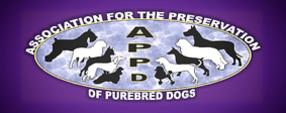
Protecting and Preserving the Heritage of our Purebred Dogs.
Although most reports on tail injuries are based on the hunting breeds such as Pointers and Spaniels. The picture below is of a dog that has what is called "Happy tail: This type of injury occurs when a dog with an outgoing personality and a long tail repeatedly thwacks the tail against a hard surface such as a crate or wall. Really happy dogs — think Golden Retrievers or Cavaliers — or dogs with thin, delicate skin, such as Dobermans or Boxers, wag so hard and fast that a bleeding ulcer can develop on the tip of the tail. In chronic cases, the only solution is to amputate the end of the tail. Despite the name, there's nothing happy about this injury."
Rebuttal to the Alberta Veterinarian associations MY Tail and I brochure.
Produced by:
Association for perservation of Purebred dogs
Does docking cause communication problems?
Dog communication comes in a variety of forms and is part of the foundation of dog social behavior. Dogs use certain movements of their bodies and body parts and different vocalizations to express their emotions. There are a number of basic ways a dog can communicate its feelings. These are movements of the ears, eyes, eyebrows, mouth, nose, head, tail and entire body, as well as barks, growls, whines and whimpers, and howls. Tail-docking in dogs can improve the animals life. When done by a veterinarian, tail-docking causes no physical or socialization problems in your puppy's future. Docked puppies are loveable, huggable, balanced and stable; the result of quality breeding and veterinary care.
If the harness or protectors do not prevent these injuries from reoccurring then tail amputation must be preformed. Tail injuries may require more than one surgery which are performed under general anesthetic and some dogs never regain their full mobility..
Why do some dogs have long tails and others do not?
Not all puppies are born with short tails. Some are actually bobtailed, for example some Corgis and Australian Cattle Dogs. Other breeds have naturally shorter tails that are curly tails, example the Bulldog. Others require tail shortening or docking when the pups are a few days old. Certain breeds have fragile tails that are easily broken like the Doberman, Boxer and Weimaraner or the hunting dogs such as Spaniels and pointers. These breeds have a high incidence of tail injuries when they are left undocked.
Since docking was banned in Sweden, there has been a measured increase in tail injuries amongst previously docked breeds. Within the 50 undocked Pointer litters registered in a year, 38% of dogs suffered tail injury before they were 18 months old. By four years of age, the number increased to 51% of the group. http://www.cdb.org/case4dock.htm. In the United Kingdom breeds previous docked like the Boxer and the Doberman survive with the use of tail harness and wide range of tail protectors for dogs suffering from reoccurring injuries.
Are there Repercussions for a traditionally docked breed to be left undocked?
What you may not know.
The prohibition of docking in other countries has also lead up to an 80% drop in registration for some traditionally docked breeds. The number of Boxers and Doberman Pinschers are declining quickly and are at risk of becoming endangered . Already breeds like the Old English Sheepdog and Pembroke Welsh Corgi, with fewer than 300 annual registrations, face extinction and are currently on the rare breeds list in the UK. In an effort to save the working breeds an amendment was made allowing veterinarians to dock service dogs, leaving the general public to deal with these injuries on their own. Even with this amendment it still has not been enough to save these traditionally docked breeds from injuries or possible extinction.
What can you do to help.
The next time you want to buy a puppy, do research on the breed you desire. Reputable breeders know their breed and work hard to produce dogs that are healthy and bred to the breed standard. Support your local veterinarian and breeder by purchasing a puppy that has been health tested and has received veterinary care. Or you could also give a rescue a much needed home by adopting. The choice is yours.
Are there problems for a traditionally docked breed if left undocked?
The procedure of docking tails at 2-4 days of age does not leave a puppy with long lasting pain nor is it a traumatic experience resulting in behaviour changes. Once performed it provides a lifetime’s protection against far more serious injuries. Tail injuries to undocked working dogs are extremely distressing and deeply painful. Long haired, thick coated breeds are docked to avoid the hair around the base of the tail becoming fouled by feces. If allowed to get out of hand, it can lead to severe problems of hygiene. These problems are greatly reduced or eliminated altogether by docking the tail. When tail docking is performed properly no animal suffers and there is no after care.